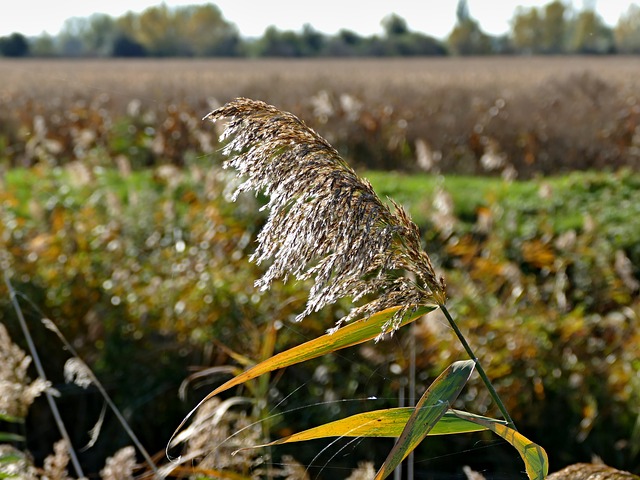 |  |  |   |   |
  |  |  |
Common reed is a perennial plant, with a long (up to 2m) creeping root and a strong, hollow, leafy, upright stem (up to 5m). Leaves linear-lanceolate, flat, with sharp edges. Long, rare hairs on the underside of the leaf. The plant is durable because of the hollow stem.
At the top of the stem, a dense pyramidal broom is formed, 20-50 cm long. Inflorescences are dark purple, brown or yellow, each with 3-7 flowers. The lowest flower is male, the others bisexual. The reed begins to bloom in June and the flowering lasts until mid-autumn. Fruit - an elongated grain. The fruits do not always ripen.
Young shoots, stems and leaves, as well as fruits and roots are collected for medicinal purposes. The young stems and leaves are harvested in mid-May and June. Dry spread out in a shady and well-ventilated place, stirring the drug frequently.
Reed roots are dug from the bottom of rivers and other bodies of water in early spring until the moment when the plant begins to bloom or are harvested in late autumn (October-November). The roots are washed and then dried in ovens or ovens, not exceeding a temperature of 50C. A well-dried drug crumbles well and has a pleasant, sweet taste. In dried form, the surface part of the plant is stored for up to 1 year, the roots for up to 3 years.
Young cane roots contain many trace elements and vitamins (B1, B2), ascorbic acid, carbohydrates (50%), proteins (1%), fat (1%), fatty acids, up to 50% starch, 32% fiber. Amino acid L-pronine, nitrogen-containing compounds, alkaloids, gentian acid, caffeic acid, cellulose, carotene and phytoncides are found in the composition of the root.
The stems have a high content of cellulose, ascorbic acid and essential amino acids. The leaves contain large amounts of vitamin A. Ferulic acid, p-coumaric acid, vanillic acid, flavonoids, orientin, proline, svercizin, etc. have been found in common reed inflorescences.
Ārstnieciskā nozīme
Parastās niedres ārstnieciskās īpašības ir pamatojamas
ar vitamīnu un minerālu klātbūtni augā.
Lai arī augs pilnībā nav izpētīts, šādas tādas zināšanas par to ir. Niedrei
piemīt pretiekaisuma, antioksidanta, diurētiskas īpašības. Saknes novārījums ir
ieteicams dažādu izvadorgānu sistēmas iekaisumu ārstēšanai.
Saprotams, ka izsens parastā niedre tiek pielietota tautas
medicīnā. Niedres saknenim piemīt žulti dzenošas, urīna dzenošas, sviedru
dzenošas, drudža mazinošas, pret tūskas un vemšanu novērsošas īpašības. Sakneņa
novārījumi, aplikāciju veidā ātrāk nobriedina furunkulus un karbunkulus, kā arī
palīdz dziedēt abscesus un brūces.
Novārījumi no lapām tiek lietoti saindēšanās gadījumā, ārīgi
ādas iekaisuma gadījumā. Stublāju sula noder indīgu insektu kodumu apstrādei.
Pateicoties lielam askorbīnskābes saturam, niedres lapu novārījums ir efektīvs
saaukstēšanās slimību gadījumā un ir izmantojams, kā pretiekaisuma un drudža
mazinošs līdzeklis. Augu lieto diskomforta mazināšanai kuņģī, lai novērstu
vemšanu un atraugas, kā arī nieru un urīna izvades sistēmas infekciju ārstēšanai.
Niedres preparātus iesaka lietot pneimonijas, pārtikas
saindēšanās un cukura diabēta gadījumā. Sakneņa novārījumus izmanto ārīgi-
artrītu, radikulītu gadījumā, kā sāpju remdējošus un pretiekaisuma līdzekļus.
Spirta izvilkumi noder cistīta un izdales sistēmas slimību
ārstēšanai. Lapu vai sakņu novārījums ir lielisks vitamīnu līdzeklis, lai
stiprinātu imunitāti, tos lieto arī anēmijas un avitaminozes gadījumā. Žāvētas
un saberztas pulverī lapas noder lielu, pūžņojošu brūču un čūlu ārstēšanai.
